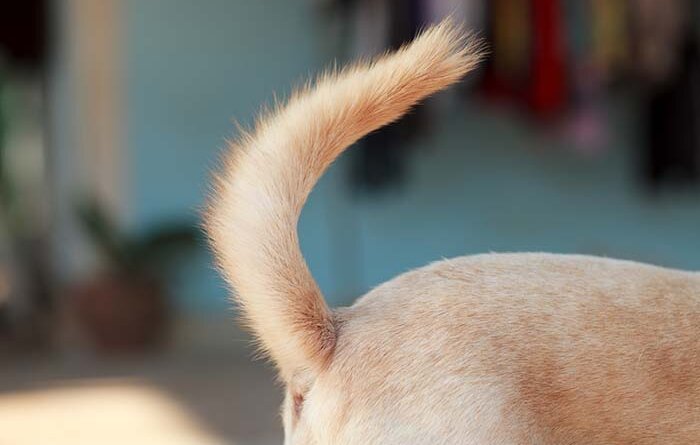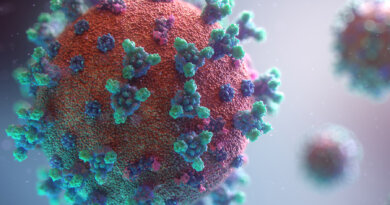Happy Tail Syndrome Can Be Painful for Dogs
All pet parents know that a dog expresses their happiness with a wagging tail. A dog’s tail is a big part of its body language.
I know my dog and others love excessive tail wagging without any spacial awareness.
Fortunately, she doesn’t have a strong enough tail but many dogs end up injuring themselves.
This injury is called the Happy Tail Syndrome, and while it’s common and even “normal” among canines, it’s still a painful and bothersome experience that may recur in dogs.
Fortunately, as a pet owner, you can do something to prevent the Happy Tail Syndrome from hurting your pup.
There are some treatments and behavioral fixes you can do to ensure that your dog won’t suffer from this condition, which is also known as splitting tail or kennel tail.
How Happy Tail Syndrome Happens
Ever notice how hard dogs wag their tail when they’re extremely excited about something?
If you arrive home from work or if they’re in the park and notice interesting things, they wag their tails to indicate their feelings.
Larger dogs like Labrador Retrievers are more prone to developing Happy Tail Syndrome because they have long muscular tails.
Very active dog breeds that are bright, energetic and always excited are at higher risk as well, according to Dr. Carrie Uehlein.
Moreover, short-haired dogs, such as the Greyhound or Dalmatian, could easily hurt themselves if they wag too hard and hit their tails on a hard surface like a chair or a door.
Breeds like these two also have whip-like tails, which contributes to developing happy tail syndrome.
Depending on the breed, some have thin skin covering that offers little protection, especially if you’ve got a super excitable dog.
Now, hitting their tails might cause some nasty cuts and splits toward the tail tip.
Sometimes, this injured tail tip could form an open wound and start bleeding.
The problem is the tissues around the tip of the tail don’t heal fast because there aren’t as many blood vessels at the tip.
This consistent issue causes nerve damage to the injured area, among other problems.
Sometimes, it progresses to licking and tail biting, which only makes it worse.
This creates a cycle of tail injuries and possibly developing an infection.
In worst cases, part of the tail may be amputated to prevent the infection from spreading all over the dogs’ body.
RELATED: How to Calm Down a Dog
How To Treat Happy Tail Syndrome
It’s difficult to treat a dog with Happy Tail Syndrome because they can’t help themselves from wagging.
The bandage that’s supposed to stop the bleeding could fall off if it’s not properly wrapped.
It’s best to let the veterinarians do it first and then learn how it is done. The bandage has to be changed and the tail has to be cleaned daily to prevent an infection. The vet will also evaluate if the dog needs further medication for the bacterial infection, apart from swabbing the tail’s wound and covering it with a bandage.
Sometimes, the tail might have broken vertebrae or damaged tendons. So, the vet might attach a special device on the dog’s tail to keep it still until it heals.
The injured dog will have to wear a veterinary recovery collar, also known as the Elizabethan collar or pet cone, to prevent him from chewing and taking off the bandage.
Preventing Happy Tail Syndrome
Training your dog to curb his excitement can help prevent overly eager tail wagging incidents. Encourage calmer behavior by not showing any attention to an over-excited dog. Instead, reward the dog if it stays calm.
Dogs also pick up on your energy, so if you’re calm, you can influence your pup to manage his excitement as well.
Give your dog plenty of exercises, toys, and room to play to temper down the over-excitement. If they’re constantly stimulated during the daily walks, they’ll able to drain their energy in the most positive way.
Never confine your dog in spaces where he’s likely to hit his tail against walls or surfaces. If he’s a crate, make sure that it is large and comfortable enough.
FAQs
Does happy tail hurt dogs?
Yes, happy tail syndrome is a painful condition once it starts.
Since dogs hit their tail on hard surfaces with enough force, it will reinjure the tail.
Typically it is dealt with veterinarian intervention: pain medication and sedation. It’s unfortunate but it is to prevent the dog from wagging their tail until it finishes the healing process.
Can you treat happy tail syndrome at home?
Yes, but only in the beginning stages. You can buy coconut oil, balms and other moisturizers to keep the tail from cracking or bleeding.
If you can keep it from progressing and as long as it is mild you won’t require treatment from a veterinarian.
READ NEXT: 9 Emergency Dog Health Conditions That Cannot Be Delayed





